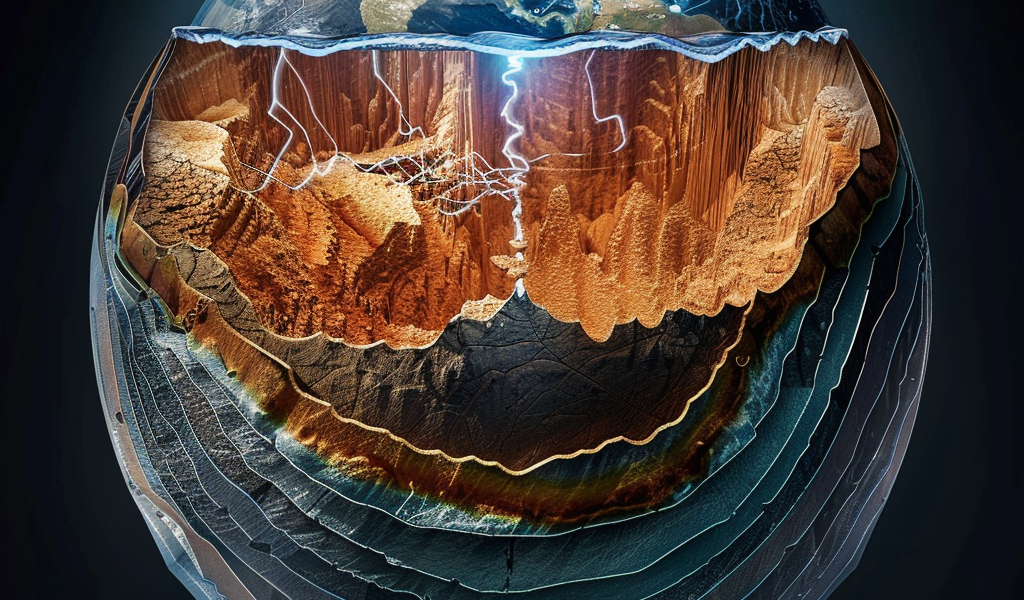Deep beneath the Earth’s surface lies an astonishing reservoir of water, estimated to contain three times the volume of all the oceans combined. This remarkable discovery sheds light on the complex dynamics of our planet’s geology and the origins of Earth’s water supply.
The findings stem from a comprehensive study conducted by a team of researchers in the United States, who utilized 2,000 seismometers to analyze seismic waves generated by over 500 earthquakes. By measuring the speed of these waves at varying depths, the scientists were able to infer the types of rocks the waves traversed before reaching the sensors.
One of the key discoveries was made approximately 700 kilometers (about 400 miles) beneath the Earth’s surface, in a region known as the “transition zone” that separates the upper and lower mantle. Here, researchers identified a unique rock called ringwoodite, which is believed to form only under the extreme pressures found deep within the Earth.
Ringwoodite has captivated scientists due to its ability to contain significant amounts of water within its molecular structure. Unlike liquid water, the water in ringwoodite is trapped, making it a crucial component in understanding the Earth’s water cycle.
Geophysicist Steve Jacobsen, who was part of the research team, explained, “The ringwoodite acts like a sponge, soaking up water. Its crystal structure is special because it can attract hydrogen and trap water effectively.” This mineral can hold up to 1.5 percent water under the intense conditions of the deep mantle, a finding that aligns with the seismic data collected during the study.
The researchers estimated that if just 1 percent of the rock in the transition zone consists of water, it would equate to a volume of water that is three times greater than that found in all of Earth’s oceans combined. This significant finding indicates that there may be a vast reservoir of water hidden deep within the Earth.
Further analysis suggested that the presence of water in the transition zone could lead to melting in areas where the lower mantle experiences flow. Seismologist Brandon Schmandt noted, “If there is a substantial amount of H2O in the transition zone, then some melting should take place in areas where there is flow into the lower mantle, which is consistent with our findings.”
Jacobsen posited that this research contributes to the growing body of evidence supporting the theory that Earth’s water may have originated from within the planet itself. He stated, “We are beginning to see evidence for a whole-Earth water cycle, which may help explain the vast amounts of liquid water present on the surface of our habitable planet. Scientists have been searching for this elusive deep water for decades.”
The implications of this study extend beyond mere curiosity; they could reshape our understanding of geological processes and the history of water on Earth. As scientists continue to explore the depths of our planet, discoveries like these highlight the intricate connections between geology and hydrology.
This groundbreaking research was published in the esteemed journal Science, marking a significant milestone in the field of geophysics and our understanding of Earth’s internal processes. The study opens new avenues for future research, as scientists seek to unravel the mysteries of the Earth’s mantle and its role in the planet’s water cycle.
As we delve deeper into the Earth’s structure, the potential for new discoveries remains vast. The findings regarding ringwoodite and its capacity to store water not only enhance our knowledge of the planet’s composition but also raise intriguing questions about the origins of water and its distribution throughout Earth’s history.
In summary, the discovery of a substantial water reservoir in the transition zone between the upper and lower mantle underscores the complexity of Earth’s internal processes. With ongoing research, scientists are poised to uncover even more about the hidden depths of our planet and the vital role water plays in shaping its geology and environment.





